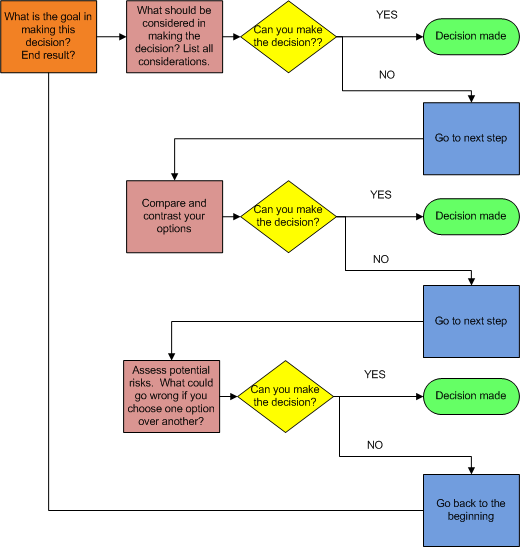
Indecision
How do you make decisions? Which of these can you relate to?
Reactive: Do the first thing that comes into your head. No planning, no brainstorming – just react immediately. No thoughts about the impact of the decision. You feel like you have to make a decision quickly.
Or…
Proactive: Think about the options – plan, brainstorm with others. Think about the effect of the decision on your long-term strategy.
Or…
Wait and see what happens: Maybe if you don’t make a decision – the problem will go away or the decision will get made for you. Are you afraid to put yourself out there in case the decision you make isn’t the right one?
We all have to make decisions in our lives – from something as simple as what to make for dinner to a more strategic decision on whether or not to launch a new product or service in our business.
Try the following the next time you have a decision to make:
|
Think About/Consider:
|
For Example
|
- What is the goal in making this decision – what is the end result?
|
- To choose between two candidates for a job?
- Whether to do one project over another?
|
- What should be considered in making the decision?
|
- The skills and knowledge of the two candidates. Their potential for growth within the organization. Their ability to do the job with limited oversight. Their ability to be part of the team and adjust to the culture.
- Which project will drive profit? Which project will better meet the needs of clients? Which project can help toward reaching the company’s strategic long-term goals? Can one project be accomplished faster than the other thereby getting to market quicker with a new product?
|
- Compare and contrast your options
|
- Develop a “pros” and “cons” list for each candidate. Include the candidates’ fit for the company’s culture.
- Which project will provide: more revenue, quicker time to market, more closely aligned to strategic goals, enable more effective competition in marketplace, etc.
|
- Assess potential risks – what could go wrong if you choose one option over the other?
|
- What if the candidate does not work out? What are your alternatives?
- What if the project you choose does not drive more revenue? What if the project fails – over schedule or over budget?
|
- Make your decision – based on the points above, which choice is the best? Which one gets you to your desired end result? Which one has acceptable risk?
|
- Choose the candidate with more “pro’s” than “con’s.” Choose the candidate who appears to be a better fit for the company culture and has more experience to get up to speed quicker.
- Choose the project with more “pro’s” than “con’s.” Choose the project which will drive revenue quicker and enable for better competition in the marketplace. Choose the project that is more desired by the customer.
|
A Decision Making Process

Summary
Even decisions that need to be made quickly can follow a process. There is no need to rush to a decision – take a little time to make sure you are making the best decision. You still might make a mistake – no biggie. Fix it and move forward. This is only one potential process for making a decision. Tweak this so it works for you.
How do you go about making decisions? Do you have a process you follow?
Please share with others in the Comments field below.




